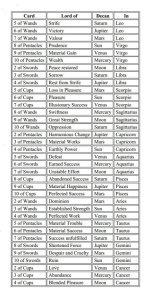BSwett
I want to express my confusion.
There just always seems to be a void, a black hole, at the point where one questions why and from where did Waite/Smith come up with the meaning of the pips. I know about the Golden Dawn, and Sola Busca, and Ettiella, but for me, there still is a missing link? When did the Marseille's ten swords stab a man in his back and left him bleeding to death just before sunrise? Who took the five cups and spilled two of them, leaving that poor fellow with a sticky mess to clean up?
I just finished reading Robert M. Place's "The tarot. History, Symbolism and Divination", and my mind grew with excitement and anticipation as I approached the section on A.E Waite's minor arcana. This book is so fantastically full of history and information. Surely Mr. Place is gonna dig into this matter….
After pages and pages on the Trumps, the symbolism attached to them, the sources from ancient times, etc. I found three vague pages on the minors describing only the relationship of the suits with the four elements and the four Jungian functions. In all honesty, the Major Arcana is made up of universal archetypes that need no explanation. One can piece this story together with a little knowledge of history, a dash of intuition and two or three whiskers of a white siamese cat. But the RWS minors and their very specific (and lovely) illustrations are not so easy to cuddle with. Specially when one considers the often conflicting meanings in relation to the drawings.
I've been reading the Marseille trumps for 25 years. They are a big part of who I am, and now I want to get familiar with the minors (Help! This triggers many other questions). At the same time, i just recently started my relationship with the RWS and I love the possibilities this cards present. Still, I've always been a nerd in the way that whenever I get into something, i go deep into it. I get lots of books, I research, I geek out, I ask questions.
This questions are not meant to ruffle any feathers but mine, they come from a very sincere place inside me. Some say that the Golden dawn was a secret sect, and because of this, not all sources and information had to be revealed; the thing is, we are talking about a best seller deck of cards that one can buy on Amazon.com, so if the secret is out lets let the Judgment's trumpet blow and uncover the truth.
I doubt (yet hope) that anyone can just come and post the answers I'm looking for here in this forum, but if somebody wants to point me in the right direction so that I can further feed the fire of knowledge; please. And thank you.
BeeSwax.
There just always seems to be a void, a black hole, at the point where one questions why and from where did Waite/Smith come up with the meaning of the pips. I know about the Golden Dawn, and Sola Busca, and Ettiella, but for me, there still is a missing link? When did the Marseille's ten swords stab a man in his back and left him bleeding to death just before sunrise? Who took the five cups and spilled two of them, leaving that poor fellow with a sticky mess to clean up?
I just finished reading Robert M. Place's "The tarot. History, Symbolism and Divination", and my mind grew with excitement and anticipation as I approached the section on A.E Waite's minor arcana. This book is so fantastically full of history and information. Surely Mr. Place is gonna dig into this matter….
After pages and pages on the Trumps, the symbolism attached to them, the sources from ancient times, etc. I found three vague pages on the minors describing only the relationship of the suits with the four elements and the four Jungian functions. In all honesty, the Major Arcana is made up of universal archetypes that need no explanation. One can piece this story together with a little knowledge of history, a dash of intuition and two or three whiskers of a white siamese cat. But the RWS minors and their very specific (and lovely) illustrations are not so easy to cuddle with. Specially when one considers the often conflicting meanings in relation to the drawings.
I've been reading the Marseille trumps for 25 years. They are a big part of who I am, and now I want to get familiar with the minors (Help! This triggers many other questions). At the same time, i just recently started my relationship with the RWS and I love the possibilities this cards present. Still, I've always been a nerd in the way that whenever I get into something, i go deep into it. I get lots of books, I research, I geek out, I ask questions.
This questions are not meant to ruffle any feathers but mine, they come from a very sincere place inside me. Some say that the Golden dawn was a secret sect, and because of this, not all sources and information had to be revealed; the thing is, we are talking about a best seller deck of cards that one can buy on Amazon.com, so if the secret is out lets let the Judgment's trumpet blow and uncover the truth.
I doubt (yet hope) that anyone can just come and post the answers I'm looking for here in this forum, but if somebody wants to point me in the right direction so that I can further feed the fire of knowledge; please. And thank you.
BeeSwax.


